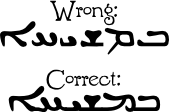
This particular tattoo I came across is “correct.” Well… the problem is that it’s too correct. Bear with me as I try and explain why.
Generally, when you look up a word in an Aramaic or Hebrew dictionary, things are organized by lemma. What is a lemma you ask? A very good question, as (ironically) most dictionaries define this term with even more lexical jargon. I would see things as:
A lemma is a form of a word defined by convention for indexing purposes.
For example, say you go to an English dictionary to look up the word “went.” For those who are well versed in English, it’s obvious to turn to the G section and look up the verb “go.” This is because by convention in English dictionaries, verbs are listed by their roots rather than by inflected forms. So, in this case, “go” would be the lemma for “went.”
Now in Aramaic, the system of lemmas is slightly different (as it is with every language), and furthermore, Aramaic lemmas may be different between dialects. A good example of such a difference occurs between Jewish and Syriac Aramaic, but to understand why you need to know that in Aramaic, nouns have three forms:
- The Absolute state (the general form of the word,); A masculine example טָב (tâv: “good”/”good one”); A feminine example טָבָא (tâvâ: “good”/”good one”).
- The Construct state (a form that indicates relationships between words); A masculine example טָב (tâv: “good”; same as absolute); A feminine example טָבַת (tâvath: “good”).
- The Emphatic state (a form that originally indicated “definiteness” similar to “the” in English); A masculine example טָבָא (tâvâ: “the good”/”the good one”); A feminine example טָבְתָא (tavthâ: “the good”/”the good one”).
Where Jewish Aramaic linguists have cataloged their words in the Absolute state, Syriac Aramaic linguists have cataloged their words in the Emphatic. Why? In Syriac dialects, the Emphatic state, over time, lost its original use as a way to determine definiteness and became the “regular” base form for words in everyday speech. To them, it made more sense to organize things by what was used the most in common vernacular, so that’s exactly what they did.
So what was the result? We have this historical fork in Jewish Aramaic classification and Syriac Aramaic classification, and for the longest time, never the twain would meet; however, in modern times, this generally has not been too much of a big deal. A new convention has been adopted by listing both the Absolute and Emphatic forms, one after another. The best of both worlds.
Now where does this leave us with the photo I showed you at the top of the page? Well, the owner believes that they have the word for “Grandfather” tattooed on their back.
Do they? Yes and yes. Twice. Our tattoo in question can be interpreted as:
סָבָּא, סָב
sâbâ, sâv
סָבָּא (sâbâ) is the
Emphatic form of the word for “Elder” or “Grandfather.”
סָב (sâv) is the
Absolute form of the same word. Yikes!
What our friend above has tattooed on his back literally says “Grandfather, Grandfather” or (if the words were reversed and we were to ignore the comma) “Grandfather’s Grandfather.” He took the whole lexical entry, rather than the one piece he would need.
Now, if I’ve said it once, I’ve said it hundreds of times on this blog: If you are planning on obtaining a tattoo in Aramaic (or any other foreign language for that matter) do not rely upon anything less than an expert who is able to explain every detail of what they give you.
- Don’t trust looking things up in a dictionary on your own. As we’ve seen here, conventions between languages are different.
- Don’t trust anything you get “for free” on the internet. Yahoo Answers, most messageboards, Wikipedia, and chatrooms are right out!
- Always double-check your translation with a third party before getting it inked. Aramaic Designs does not only offer reliable translations, but a means of double-checking translations from other sources pro bono.
Peace,
–Steve




